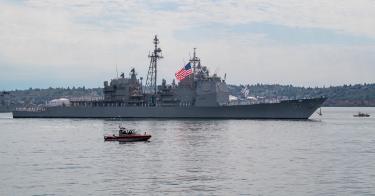Today’s Navy faces massive challenges, many reminiscent of the darkest days of the Cold War: abysmal recruiting, failing shipbuilding programs, too few ships—all eroding our capability advantages over an increasingly aggressive and confident adversary. It’s discouraging to be sure, but not insurmountable. The tenure of Ambassador J. William Middendorf II as secretary of the Navy offers an object lesson in how to overcome these serious problems.
Middendorf took the helm of the Navy in 1974. It was a low point in American history. The nation stewed in a post-Vietnam War funk. Leadership was in turmoil over the Watergate scandal. And foreign perils proliferated. Yet Middendorf was able to make decisions that helped turn the tide of the Cold War, and those decisions continue to have a positive impact today.
To reconstitute the weakened fleet he inherited, Middendorf recognized he would need to focus on the basics, starting with recruiting and retaining enough sailors and officers to man the ships. To widen the candidate pool, he expanded opportunities for women to serve in the Navy, including enrollment at the U.S. Naval Academy. To regain professional competencies, he instituted the “Golden Snipe” award for ships with top performing engineering teams. With the aid of then-chief of naval operations, Adm. Elmo Zumwalt, he also changed the service culture; better supporting spouses while improving the quality of life of all sailors during the transition to an all-volunteer force.
>>> Declining U.S. Military Strength Reveals a Deeper Leadership Crisis
In addition to strengthening naval personnel, Middendorf and his team embarked on a major modernization program, bringing forward next-generation naval systems and warships that are still serving today.
The AEGIS radar and battle management system still contributes to today’s missile defenses; Ohio class nuclear missile submarines still provide strategic deterrence; F/A-18 Super Hornets are still feared by our adversaries and delivering ordinance on the Houthis in Yemen. Nearly a half-century later, these Middendorf-era advances remain remarkably relevant to our national security, despite needing an update as China erodes our technological lead.
Of course, this didn’t come cheap. Middendorf oversaw a 60 percent growth in the Navy’s budget, even as others’ budgets were shrunk.
Middendorf’s success took money, but it wouldn’t have happened at all without a clear understanding of the nature of the threat and a willingness to act on that knowledge. He recognized that the Soviet Union was guided by an incompatible ideology that would yield only to strength. He embraced a “peace through strength” agenda that animated his energetic tenure as Secretary.
Middendorf also understood a basic truth regarding naval competition: well-trained crews, numbers of ships and range of weapons, when given faster data processing and accurate sensing, assures overwhelming victory at sea and deters war. This insight drove his decision-making. It’s what turned the tide in the old Cold War, and it’s what can turn the tide in today’s New Cold War with China. At least some leaders in Washington get this.
>>> Who Will Build the Next War-Winning Liberty Ship for America?
In recent years, Congress has insisted on reinvigorating deterrence with a stronger Navy. Yet more money alone will not get the job done. Success also requires wise decisions and urgent action. To this end, Navy Secretary Carlos Del Toro announced creation of the Office of Strategic Assessment, which can help set the foundations for a return to peace underwritten by American naval leadership.
Decades of living off the post-Cold War “peace dividend” has left the nation woefully unready for the competition with China. Today we need a Middendorf to set the foundations for a naval rejuvenation, foundations that allowed his successor, Navy Secretary John Lehman, to grow the Navy into an unbeatable force that hastened the end of the last Cold War. The same is needed today.
The nation is at a pivot point, and the actions taken today will determine success in the New Cold War or a decline into what Middendorf calls a great “nightfall” on our democratic way of life.
The lesson of his years as secretary of the Navy are clear: the Navy is critical to winning cold wars, and while it may be down, it is never out of the fight.
This piece originally appeared in the Navy Times


